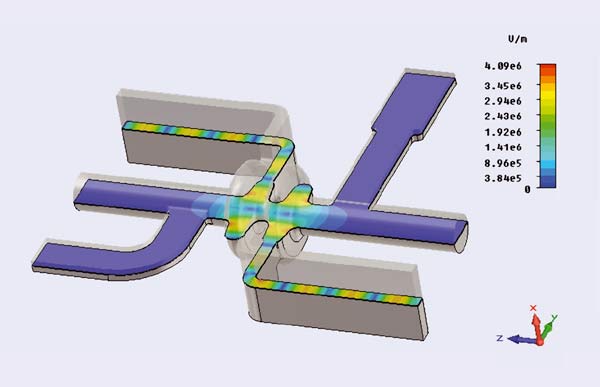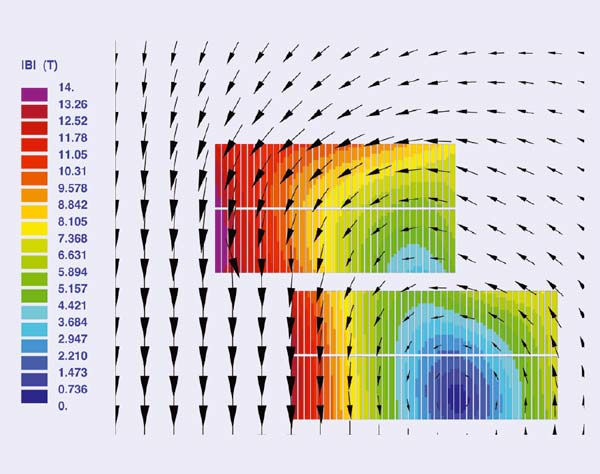All about EuCARD, a new four-year project centred on accelerator R&D.

Image credit: Cockcroft Institute/Lancaster U.
A sustained effort to develop the potential and performance of particle accelerators is a key ingredient of experimental particle physics. It is also true for nuclear physics, light sources and myriad other applications of accelerators in research and industry. These different fields often share ambitious R&D challenges – hence the idea of a common venture that brings together different partners in Europe and beyond and that focuses on top-priority accelerator R&D issues.
The Co-ordinated Accelerator Research in Europe (CARE) project, which was overseen by the European Steering Group for Accelerator R&D (ESGARD), pioneered collaborative work in accelerator R&D on a European scale. The five-year project grouped together 22 partners and more than 60 associated institutes and was co-funded by the EU’s Framework Programme 6. Combining networking and R&D, CARE had three main goals: to optimize the use of existing infrastructures: collaborate on new state-of-the-art technologies; and develop links between accelerator physicists and particle physicists.
CARE’s networking activities enhanced European knowledge to investigate efficient and cost-effective methods to produce intense and high-energy electron, proton, muon and neutrino beams. These are the Electron Linear Accelerator Network (ELAN) and the networks for High-Energy High-Intensity Hadron Beams (HHH) and Beams for European Neutrino Experiments (BENE). R&D activities within CARE included:
• Superconducting Radio Frequency (SRF) to investigate superconducting cavity technology with a gradient exceeding 35 MV/m
• PHIN, an activity for photoinjector technology for two-beam acceleration concepts, new-generation light sources and novel acceleration techniques
• High Intensity Pulsed Proton Injectors (HIPPI) to study normal and superconducting structures for the acceleration of high-intensity proton beams, as well as challenging beam-chopping magnets and beam dynamics
• Next European Dipole (NED) for research into cable technology for reaching high magnetic fields (>15 T) using high current densities (>1500 A/mm2)
When CARE came to an end on 31 December 2008, the co-ordinator, Roy Aleksan from the Commissariat à l’énergie atomique (CEA), announced that 129 deliverables and more than 700 scientific publications had been achieved, including 18 PhD theses.
From CARE to EuCARD
Beyond the scientific outcome, CARE created a favourable environment for future European projects in accelerator R&D. ESGARD triggered the preparation of a new European project, taking into account the new priorities in accelerator R&D. The result is the European Co-ordination for Accelerator Research & Development (EuCARD), a four-year project co-funded by the EU’s Framework Programme 7 (FP7), which involves 37 partners from 45 European accelerator laboratories, universities, research centres and industries. In response to the EC’s request, this project’s mandate includes a contribution to the emergence of lasting structures in the accelerator field, beyond the duration of European projects.
The EuCARD contribution brings the added value of collaborative work between accelerator laboratories, universities, specialized institutes and private companies
The EuCARD project started on 1 April 2009 and is co-ordinated by CERN, with Jean-Pierre Koutchouk as project co-ordinator, Ralph Assmann as deputy and Svetlomir Stavrev as administrative manager. Its management bodies are the Governing Board and the Steering Committee. The Governing Board represents the project partners and has elected Tord Ekelof, of the University of Uppsala, as chair. The Steering Committee represents the project’s activities, with all work-package co-ordinators and deputies as members. A co-ordination office at CERN offers central support to the community, benefitting from the active involvement of the CERN’s EU Office.
The collaborative R&D programme includes 21 “tasks” grouped under five themes (work packages), described in more detail below. Most studies are deeply rooted in the work plans and funding of the collaborating laboratories, thereby providing a robust environment. The EuCARD contribution brings the added value of collaborative work between accelerator laboratories, universities, specialized institutes and private companies.
Five themes
The theme “High-field magnets”, led by Gijs de Rijk of CERN and François Kircher of the CEA, involves 13 partners. The primary goal is a new jump in achievable magnetic fields, rated as the top priority by the EC project review. This includes the study, design and construction of a model 13 T niobium–tin (Nb3Sn) accelerator dipole. The study and construction of a very ambitious inner coil “booster” to be added to this dipole aims to reach significantly higher fields, possibly 20 T. Potential applications are test stations for superconducting cables (e.g. FRESCA at CERN); phase II of the LHC upgrade; wigglers and undulators; and all accelerators requiring more compactness. Two associated studies will investigate the use of high-temperature superconductors for superconducting links and of Nb3Sn for short-period helical undulators for the International Linear Collider (ILC) positron source.

The theme “Collimation and materials”, led by Ralph Assmann of CERN and Jens Stadlmann of GSI, involves nine partners. Robust and efficient collimation is a necessity and a challenge for both the LHC and the future Facility for Antiproton and Ion Research (FAIR) at GSI. This theme is recent in accelerator sciences and includes the successive steps necessary to allow collimator implementation: beam modelling; energy deposition calculations; behaviour of materials, especially under shock waves (accidental beam loss); radiation damage; and implementation and testing of warm and cold collimators.
The theme “Linear colliders”, led by Grahame Blair of Royal Holloway, University of London, and Erik Jensen of CERN, involves 11 partners. It has two aspects: technologies for the Compact Linear Collider Study (CLIC), with two-beam acceleration; and the stabilization and beam delivery issues that are common to CLIC and the ILC. The studies include: the design and construction of improved power extraction and transfer structures for CLIC Test Facility 3; the demonstration of higher-order mode (HOM) damping in the presence of alignment errors; breakdown simulations and diagnostics instrumentation; and precise synchronization devices with 20 fs resolution. Stabilization will be investigated for the linac and final focus, using purposely built mock-ups, with targets of 1 nm and 0.1 nm respectively. Beam delivery methods and instrumentation for emittance preservation will be investigated on the Accelerator Test Facility 2 in Japan and on PETRA III at DESY.
The theme “Superconducting radio frequency technologies” is led by Olivier Napoly of the CEA and Olivier Brunner of CERN and it involves 15 partners. This is the largest work package of EuCARD and covers various aspects of the superconducting technology applied to the production of RF fields and related topics. It will study new technologies being investigated for superconducting thin-film deposition. Using bulk material, accelerating cavities will be developed for hadron linacs and investigations carried out on couplers, mostly with a view to reliable and industrial cleaning. New, advanced telecommunication computing-architecture technology will be applied to low-level RF, with an application at the free-electron laser facility, FLASH, at DESY. On the same machine, investigations will be done on the HOM signals used as beam-diagnostic devices. An improvement programme for the superconducting RF gun at the Electron Linac for beams with high Brilliance and low Emittance (ELBE), Forschungszentrum Dresden-Rossendorf, covers beam characterization and the preparation and characterization of photo-cathodes.
The fifth theme, “Innovative accelerator concepts”, is led by Marica Biagini of INFN and Rob Edgecock of the UK’s Rutherford Appleton Laboratory (RAL) and involves five partners. It provides support for exciting innovative concepts developed in several laboratories, such as the crab-waist crossing-scheme, non-scaling, fixed-field, alternating-gradient accelerators and plasma-wave acceleration. The EuCARD contributions range from feasibility studies to beam diagnostics for a better evaluation and understanding of their upcoming implementations.
A large community
EuCARD also involves networks, which are grouped under three headings. The network for neutrino facilities (NEu2012), led by Vittorio Palladino of INFN and Silvia Pascoli of the Institute for Particle Physics Phenomenology, Durham University, aims to structure the European neutrino community for a coherent approach to the upgrade of existing infrastructures and/or a road map to new ones. The network is in liaison with EUROnu, the FP7 Design Study for A High Intensity Neutrino Oscillation Facility in Europe, and worldwide studies. The network is already active in participating or contributing to the organization of all major neutrino physics events.
The accelerator science networks (AccNet), which are led by Frank Zimmermann of CERN and Alessandro Variola of CNRS-LAL, divide into two specialized networks, though some topics such as crab cavities span them both. The accelerator-performance (EuroLumi) network continues and extends the activity of CARE-HHH on the LHC, FAIR and other accelerator upgrades, interfacing with the US LHC Accelerator Research Program. It bridges the gap between accelerator physics, accelerator technology and experimental physics, with the goal of defining optimized upgrades. The RF technologies (RFTech) network, which covers both normal and superconducting RF, encompasses all aspects of RF technology, such as klystron development, RF power distribution, cavity design, low-level RF and costing tools.
Finally, the network for scientific communication and outreach is led by Ryszard Romaniuk of Warsaw University of Technology and Kate Kahle of CERN. An important aspect of European projects and motivation for EU funding is communication, dissemination and outreach, so as to strengthen the European research area and facilitate future collaborative ventures. This network is already active, creating a website, publication portal and database, and a project newsletter. It is looking into the possibility of publishing a series of booklets on accelerator sciences and the co-ordinators welcome contact from potential authors.

Research accelerators are by nature open to a large community of users. To stimulate and support wide use of accelerator-related R&D facilities, EuCARD operates two schemes under EU rules for “Transnational Access”: the Muon Ionization Cooling Experiment (MICE), with a muon beam of around 200 MeV/c and ionization-cooling facility under development at RAL; and the High Radiation Material test facility (HiRadMat), a pulsed irradiation facility under development at CERN. In both cases more details for potential users can be found at http://cern.ch/EuCARD/activities/access.
As soon as the project started in April, the EuCARD activities entered an active phase, achieving the planned early milestones. Several articles have already been published, thanks to the anticipation of several partners. The co-ordinator and Steering Committee look forward to the collaborative work ahead.
• For more about EuCARD and its scientific events, visit http://cern.ch/eucard.





